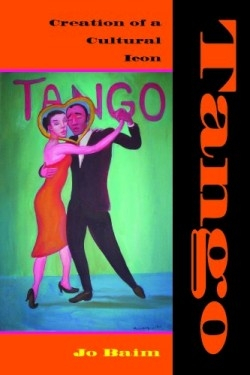
Tango
Creation of a Cultural Icon
“The history of tango is as elusive as the history of the Argentine people,” the author writes. In spite of this, Baim presents an engaging portrait of the dance and music that are synonymous with the culture of Argentina.
The author admits it is impossible to trace tango to one single source. Few photos exist to document tango movement, forcing Baim to examine newspaper articles, dance manuals, sheet music, popular art, and even women’s fashions of the late nineteenth and early twentieth centuries. The etymology of tango is likewise unclear; possibly African, a vocalization of drum sounds, or a variation of tambo, meaning “slave markets.”
As both a choreographer and a musician, Baim devotes half the book to tango dance, and half to its musical forms. The dance began as a product of the cultural mix of Argentina’s coast and port cities, where natives mingled with immigrants of Irish, Italian, German, African, and Basque ancestry. An 1856 dancer’s manual mentions tango, and citations pick up after 1880. Initially danced in working class nightclubs and bars, it became known to all strata of society by 1900. Dancers and tourists exported tango to Europe and America between 1900 and 1915. By 1920, even upper class Argentines, originally disdainful of the dance, proudly embraced it as their own.
Examining musical forms, the author discusses the various instruments in a tango ensemble (guitar, violin, flute, piano, the calliope-like organito de la tarde, and the accordion-shaped bandoneon), as well as the habanera rhythm at the base of the music. She details how both double and triple meter were used in compositions, supplying musical notation from the songs of composer Sebastian Yradier. Tango even infiltrated the music of four classically trained composers: Erik Satie, Darius Milhaud, William Walton, and Ernst Krenek.
Baim’s research brings forth tantalizing information, some of it humorous, while dispelling common misconceptions. For example, it is a myth that tango originated in the brothels and criminal element of Argentina’s population. Unfortunately, Argentina’s literary icon, Jorge Luis Borges, perpetuated the idea, and it took hold even though he recanted this position in later years. Modern readers will laugh at the public outcry, in Argentina as well as abroad, condemning tango as vulgar and promiscuous: Yale University even banned it from their prom in 1914! And Baim cites musicologist Carlos Vega’s theory that the earliest appearance of tango’s underlying habanera rhythm occurred in the rabbinical collections of medieval Spain.
Baim acknowledges that the dance people today recognize as tango is not the same as it was when it first appeared in Buenos Aires and other coastal towns of Argentina. But in following its trail she has produced a delightful text, illuminating the fascinating convergence of cultural influences that produce an art form. The book will entice cultural historians as well as lovers of dance and music.
Disclosure: This article is not an endorsement, but a review. The publisher of this book provided free copies of the book to have their book reviewed by a professional reviewer. No fee was paid by the publisher for this review. Foreword Reviews only recommends books that we love. Foreword Magazine, Inc. is disclosing this in accordance with the Federal Trade Commission’s 16 CFR, Part 255.
